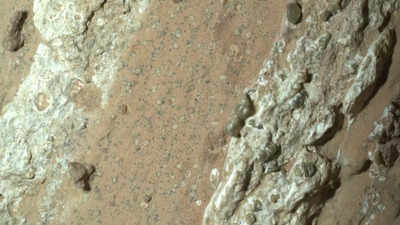Nasa’s Perseverance Rover has Uncovered What Scientists Describe as the most compeling evidence. A mudstone core drilled in July 2024 from a Rock Named “Chevaya Falls” With the bright angel region of jezro Crater has Reveled Minrarals and Texures Commonly Linked with Microobial activity on Earth. The Sample Contains Vivianite, An Iron Phosphate, and Greigite, An Iron Sulfide, bot often formed in water-rich, oxygen-poor environment. These patterns, including “leopard spot” textures, sugges ancient chemical reactions that may have supported microbial life. While nasa stresses this is not proof of life, the findings represent the closest scientists have come to identifying a potential biosignature on the red plan.
What the Nasa Rover Found Inside Mars Rocks
The drilled core revised mudstone with circular reaction Fronts called “Leopard Spots” and nodules embedded with layred sites. Instruments Aboard Perseverance, Sherloc and Pixl, Mapped Organic Carbon Ailongside Phospate, Iron, and Sulfur arranted in repeating patterns. The menrarals vivianite and greagite study out trust, on Earth, they form in microbial-influenced environments. This bullseye-Like Arrangement Mirrors Electron Transfer Reactions that Microbes Perform in Oxygen-Poor Muds. Importantly, these features developed in water-laid sediments raather than volcanic rock, strengthening the case for ancient habitability.
Why nasa calls it a potential biosignature
While the mineral structures and organic compounds resmble microbial activity on Earth, nasa scientists remain cautious. Such Signals are referred to as “Potential Biosignatures”-Features That May Indicate Life But BUT BUT BUT BUT BUT BUT BUT BUT BUT BUT BUT BUT BUT BUT BUT BUT BUTLON To guide such discoveries, nasa uses the confidence of life detection (cold) scale, which requires signals to be independently verified and alternative explanations excluded. At present, the bright angel findings rank low on this scale but mark an important milstone. Seled Samples from Perseverance are expected to be returned to Earth in the future, where advanced laboretory tests can help confirm which was truly involved.
Implications for Mars and the search for life
If confirmed, the discovery would sugges that Mars on Suported Microbial Metabolisms Similar to that that on Earth, Exteering the Timeline of Habitability to An Era When Jezero CONJERO CONTERO CONTEROTER Lakes. Even if the menrarals are to be abiotic, The Findings Still Provide Insights Into Mars’s Chemical Evolution and Its Ability to Cycle Elements Essential for Life, Such as Iron, Sulfur, and Sulfur, and Sulfur, and The PERSEVERANCE ROVER WILL Continue Exploring and Collecting Samples, While Nasa’s Planned Mars Sample Return Mission will be Crucial for Final Answers. This cautious but promising breakthrough marks a major step forward in humanity’s search for life beyond earth.



